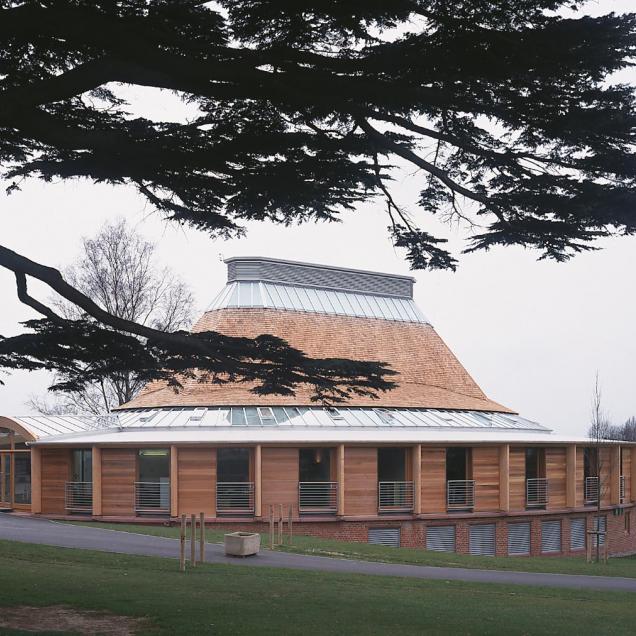

Link: CABE Case Study
The fine and mature grounds of Shrewsbury School overlook the River Severn and Shrewsbury town.
Boarding houses and teaching buildings surround playing fields. The new Music School is sensitively sited on an embankment between the upper and lower commons of the grounds, establishing the music department's presence at the centre of the school's life, whilst providing good access from the road for public performances.
The design attempts to reconcile the conflicting demands of a three-storey high auditorium, of sufficient volume to provide a good reverberation time, with the surrounding small-scale practice and teaching rooms, within one building.
Description
The rake of the auditorium seating follows the slope of the hillside, cited by the architects as reminiscent of ancient amphitheatres' use of natural hillsides for seating. The central auditorium has retractable seating and a distinctive timber roof.
Noisy activities such as percussion and amplified music are located on the lower level, insulated from the quieter activities by dense blockwork and concrete floor construction. The entrance is also roof lit, bright and welcoming, with an informal meeting area to one side and a concierge office to the other.
Entry into the auditorium is from a lobby from this area which also leads to a recording booth at the upper level of the auditorium. A mature Holm Oak very close to the site formed the main axis of the building and has become the focal point of an outdoor space by the main entrance.
The superstructure, roof decks, main roof covering, ceilings, floors and windows are all made of timber obtained from renewable sources. The auditorium achieves a reverberation time of 1.7 seconds. It is well insulated from surrounding construction through structural isolation of floor slabs and the insulation of external air paths with low-resistance sound attenuators.
Design process
The brief was for a new music school with practice rooms, teaching rooms and a large performance space, suitable for full orchestra rehearsals or a small ensemble with an audience of 200 along with specialist music facilities, including rock music, percussion, keyboards, recording/IT, staff facilities, a general office and storage space for musical instruments.
Despite the potential incompatibility of different acoustic demands, the school was keen to embrace all musical activity in the same building.
Pringle Richards Sharratt Architects carried out a masterplan for the future development of the Shrewsbury School campus and identified a suitable site for the music school, in a natural clearing between existing mature trees, part of the linear development of buildings around the central playing fields.
Various building forms were considered, and an elliptical form was chosen to maximise external frontage to give all rooms an outside view whilst having a compact internal circulation system acting as a spill out and acoustic buffer to the central auditorium space.
The design of the central auditorium developed from an elliptical to a facetted form to maximise acoustic performance. The entire timber roof structure took just two weeks for specialist carpenters to erect.
Evaluation
The building is located carefully in a sensitive historic landscape. The use of the slope of the site prevents the large volume of the auditorium from dominating the smaller rooms to the perimeter. Its steeply pitched roof is an unusual form, reminiscent of oast houses and other vernacular buildings. Combined with the natural materials of the exterior it sits well in this location.
The openness around the building does however mean that security and managing potentially unwanted access from the public road below has become a consideration. Internally the building is bright and airy and is well used. It is easy to understand what is going on in the building when walking around, and it does not feel like an institutional teaching or administration block, an appropriate resource in this boarding school situation.
For a specialised building the brief was achieved with a relatively tight budget. The arrangement of accommodation and development of the acoustic strategy have been developed carefully and effectively.
The environmental impact of the building has been minimised through choice of materials and low energy ventilation, heating and lighting systems. The building envelope is thermally efficient and exploits passive ventilation drawing air from the cool undercroft to be exhausted via vents in the top of the roof.
Project team
Architects: Pringle Richards Sharratt
Engineers(structure & services): Buro Happold
Acoustic consultants: Arup Associates
Quantity Surveyors: Davis Langdon & Everest
Control room / studio designers: Studio People
Contractor & Planning Supervisor: Bowmer & Kirkland
Project summary
Location: Shrewsbury
Completed: 2001
Client: Shrewsbury School
Design team: Architects: Pringle Richards Sharratt
Planning authority: Shrewsbury and Atcham Borough Council
Funding body: Private
Contract value: £1.35m
Researched by: School of Architecture and Planning, University of Newcastle
Further information
Architect/Designer:
Architects: Pringle Richards Sharratt
http://www.prsarchitects.com
Project Address:
The Schools
Kingsland
Shrewsbury
Shropshire
SY3 7BA
© CABE 2007